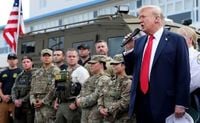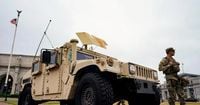On August 11, 2025, President Donald Trump stunned the nation by invoking the 1973 Home Rule Act to seize control of Washington, D.C.’s Metropolitan Police Department for a period of up to 30 days. The move, which has since sparked fierce debate and legal challenges, marks the most aggressive federal intervention in the capital’s law enforcement since the city gained limited self-governance. But for many, the story is about far more than crime statistics or administrative squabbles—it’s a flashpoint in America’s long, troubled history of race, power, and federal authority.
Trump’s justification for the takeover was blunt: he claimed D.C. was suffering from “crime, bloodshed, bedlam and squalor.” Citing a recent assault on a white protégé of Elon Musk by two Black teenagers, Trump painted the city as a hotbed of lawlessness. Yet, according to the Metropolitan Police Department, violent crime in D.C. was actually down by 27% in 2025 compared to the previous year. The U.S. Attorney’s Office had reported earlier in the year that crime had hit a 30-year low. As Capital & Main reported, the president’s portrayal of D.C. as an out-of-control city “rife with crime” was at odds with the data: “Crime in D.C. is down 26% since last year.”
Despite the numbers, Trump pressed forward, activating the National Guard and deploying federal agents to patrol the streets. On August 21, he visited a U.S. Park Police center in Anacostia, telling assembled law enforcement and federal agencies, “It’s like a different place, different city. Now, I think right now it’s better than it has been in years and in a couple of weeks, it’s going to be far better.” According to Nexstar Media Inc., Trump praised the federal presence, adding, “Washington, D.C. is SAFE AGAIN! The crowds are coming back, the spirit is high, and our D.C. National Guard and Police are doing a fantastic job. They are out in force, and are NOT PLAYING GAMES!!!”
Since the announcement of federal control, the administration reported 630 arrests—including the detainment of 250 migrants without legal status—and the seizure of 86 illegal firearms. U.S. Attorney General Pam Bondi, who joined Trump on his visit, stated that no murders had been reported in the capital that week, a point Trump echoed on Truth Social: “As bad as it sounds to say, there were no murders this week for the first time in memory.”
But the president’s claims about crime figures have been hotly contested. Trump accused Mayor Muriel Bowser of publishing “false and highly inaccurate crime figures,” warning on August 22, “Mayor Muriel Bowser must immediately stop giving false and highly inaccurate crime figures, or bad things will happen, including a complete and total Federal takeover of the City.” The Department of Justice, meanwhile, launched an investigation into D.C.’s crime reporting data, further fueling the atmosphere of mistrust and confrontation.
Local officials and residents have not taken the intervention lightly. D.C. Attorney General Brian Schwalb wrote to Bowser, calling Bondi’s directive appointing DEA chief Terry Cole as the city’s “Emergency Police Commissioner” “unlawful,” and advised the mayor that she had “no legal obligation to follow it.” The next day, Schwalb filed a lawsuit against the Trump Administration, stating he was “challenging the federal government’s unlawful attempt to take over the District of Columbia’s Metropolitan Police Department” to ensure that control “remains with the Mayor, the Chief, and the people of the District of Columbia.”
The legal standoff escalated quickly. In an emergency court hearing overseen by Judge Ana Reyes, the Department of Justice agreed to rescind its directive, no longer seeking to appoint Cole as police commissioner. Still, Bondi issued a new directive requiring D.C.’s police to comply fully with federal immigration law and authorities. In her response, Bondi accused Schwalb of opposing “efforts to improve public safety in Washington, D.C.”
Any extension of the federal takeover would require Congressional approval under the Home Rule Act, and local leaders have vowed to resist further encroachment. Bowser and Schwalb, along with many D.C. residents, argue that the intervention is less about public safety and more about undermining the city’s hard-won autonomy—especially given its unique status as a majority-Black city with a Black mayor and no voting representation in Congress.
For some commentators, the echoes of history are unmistakable. As Capital & Main noted, the only successful coup d’etat in U.S. history occurred in Wilmington, North Carolina, in 1898, when white supremacists violently overthrew a Black-led city government. The pretext then was “the menace of ‘Negro rule,’” and the result was a brutal suppression of Black political power. The perpetrators were never prosecuted, and Wilmington was never the same. “President Trump’s takeover of the Washington, D.C., police is a direct descendant of that shameful episode, an outgrowth of a culture of white supremacy that has been revived and is now ensconced in the White House,” wrote Erin Aubry Kaplan for Capital & Main.
The symbolism of Trump’s actions has not gone unnoticed. While taking over the city’s law enforcement, he also began resurrecting Confederate monuments in D.C., including bringing back a statue of Confederate general Albert Pike—a figure whose memorial was toppled during the Black Lives Matter protests. “Trump is trying to overthrow that movement, part of a broader effort to diminish and delegitimize Black power in ways that are becoming more and more blatant,” Capital & Main observed.
Trump has threatened to expand the federal takeover model to other cities with large populations of color and Black mayors, such as Chicago, Los Angeles, Baltimore, and Oakland. Critics argue that these actions are part of a broader narrative that equates Black leadership with urban decay, a narrative that has deep roots in American culture and politics. “The trend has been celebrated as real racial progress but has also run into the headwinds of Trumpism, which equates Black presence with urban decay and decay in general,” wrote Kaplan.
Perhaps most striking is the contrast between Trump’s rhetoric on law and order and his decision to pardon nearly 1,600 supporters charged for their involvement in the January 6, 2021, insurrection—the largest single-day crime wave in D.C.’s history. If the president’s true concern was public safety, many argue, he would not have granted blanket clemency to individuals convicted or accused of violent acts, including assaults on law enforcement officers.
As the legal and political battles rage on, the future of D.C.’s autonomy—and the broader implications for federal intervention in local governance—remain uncertain. What’s clear is that the events of August 2025 have ignited a national conversation about race, power, and the meaning of democracy in America’s capital.
The outcome of this confrontation will shape not only the fate of D.C. but also the nation’s ongoing struggle to reconcile its ideals with its history. For now, the city stands as both a symbol and a battleground, caught between competing visions of law, order, and justice.



